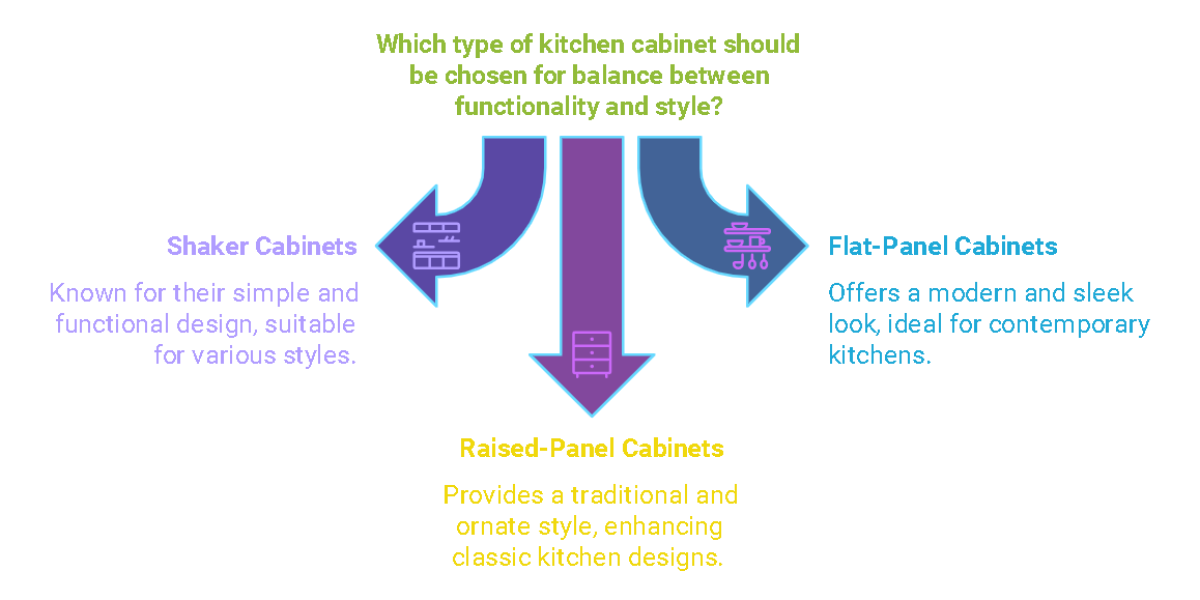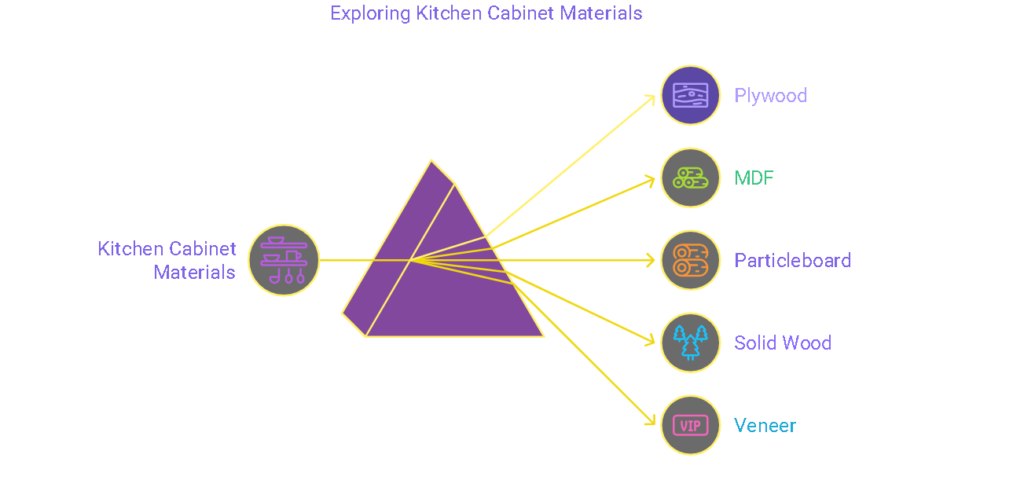
The kitchen is the central space of the home, where meals are prepared, stories are shared and memories are made. As such, having a kitchen that is both functional and aesthetically pleasing is essential. One of the most transformative ways to achieve this is by opting for a designer modular kitchen. Central to any modular kitchen design are the cabinets, which define the space’s style, functionality, and organization. In this blog, we delve into everything you need to know about kitchen cabinets for a designer modular kitchen, helping you create the kitchen of your dreams.
What is a Designer Modular Kitchen?
A designer modular kitchen is a modern and stylish kitchen layout that comprises pre-manufactured modules or units, including cabinets, shelves, and drawers. These units are designed to optimize space and functionality while maintaining a high aesthetic appeal. Modular kitchens offer flexibility, as they can be tailored to fit your specific requirements, making them an ideal choice for contemporary homes.
The Importance of Kitchen Cabinets in Modular Kitchens.
Kitchen cupboards are the foundation of any secluded kitchen. They not only provide essential storage but also contribute significantly to the overall look and feel of the space. Here’s why they are indispensable:
Storage Optimization: Cabinets help you organize kitchen essentials like utensils, cookware, and groceries efficiently.
Tasteful Allure: Architect cupboards come in different materials, varieties, and completions that can lift your kitchen’s style.
Sturdiness: Top notch cupboards are worked to endure the mileage of everyday kitchen exercises.
Customizability: Modular kitchen cabinets can be customized to fit your specific needs, whether you need more drawers, pull-out units, or open shelves.

Types of Kitchen Cabinets for a Designer Modular Kitchen.
Picking the right sort of kitchen cupboards is significant to accomplishing the ideal equilibrium between usefulness and style. Here are some popular types:

1. Base Cabinets
These are the foundation of your kitchen design. Positioned under the countertop, base cabinets provide storage for heavy items like pots, pans, and appliances. They also house sinks and cooking ranges.
2. Wall Cabinets
Mounted on the walls above the countertop, these cabinets offer convenient storage for items used frequently, such as spices, plates, and glasses. Wall cabinets are ideal for maximizing vertical space.
3. Tall Cabinets
Tall cupboards are ideal for storeroom capacity or for putting away cumbersome things like brushes and wipes. They reach out from the floor to the roof, offering more than adequate capacity.
4. Corner Cabinets
Designed to make use of awkward corner spaces, these cabinets often feature pull-out shelves or carousel units for easy access.
5. Open Shelving
For a modern and airy feel, you can incorporate open shelving units. These are great for displaying decorative items or frequently used kitchenware.
Cabinet Finishes: Adding Style to Functionality.
The finish of your kitchen cabinets is what defines their overall appearance. Here are some popular options:

1. Laminate Finish
Laminate is a durable and cost-effective option available in a wide range of colors and textures. It’s not difficult to keep up with and impervious to scratches and stains.
2. Acrylic Finish
For a glossy and ultra-modern look, acrylic finishes are a top choice. They are resistant to moisture and scratches but require regular cleaning to maintain their shine.
3. Matte Finish
Matte finishes offer a subtle and sophisticated look. They are less reflective and easier to maintain than glossy finishes.
4. Veneer Finish
Veneer gives the regular look of wood and is great for creating a warm and exquisite kitchen.. Be that as it may, it requires appropriate fixing to forestall harm.
5. Glass Finish
Glass-front cabinets are perfect for showcasing beautiful dishware or decorative items. Frosted or tinted glass adds an extra layer of style and privacy.

Popular Design Styles for Modular Kitchen Cabinets.
Your choice of cabinet design style sets the tone for your kitchen. Here are some popular styles:
1. Contemporary
Featuring clean lines, minimalist aesthetics, and sleek finishes, contemporary cabinets are ideal for modern homes.
2. Traditional
Traditional cabinets often feature intricate detailing, raised panel doors, and classic finishes like wood or veneer.
3. Rustic
Rustic cabinets bring a warm and cozy feel to the kitchen with their distressed wood finishes and earthy tones.
4. Industrial
Industrial-style cabinets incorporate raw materials like stainless steel, concrete, and exposed hardware for a bold look.
5. Transitional
A blend of traditional and modern styles, transitional cabinets offer the best of both worlds with their balanced design.
Functional Additions to Enhance Your Cabinets.
To make your designer modular kitchen truly efficient, consider these functional additions:
Pull-Out Shelves: Easy access to deep cabinets.
Soft-Close Hinges: Prevents doors from slamming shut.
Drawer Organizers: Keeps cutlery and utensils organized.
Built-In Lighting: Illuminates cabinet interiors for better visibility.
Magic Corners: Utilizes corner spaces effectively.
Tall Pantry Units: Maximizes storage for dry goods.
Maintenance Tips for Kitchen Cabinets
To keep your designer modular kitchen cabinets looking new, follow these maintenance tips:
Clean Regularly: Wipe cabinets with a damp cloth to remove grease and dust.
Avoid Harsh Chemicals: Use mild cleaners to prevent damage to finishes.
Check Hinges and Handles: Tighten loose screws and replace damaged hardware.
Protect from Moisture: Use exhaust fans to reduce humidity in the kitchen.
Polish Wood Cabinets: Apply polish periodically to maintain their shine.

Why Choose a Designer Modular Kitchen?
A designer modular kitchen is more than just a trend; it’s a lifestyle upgrade. Here’s why it’s worth investing in:
Customization: Tailored to fit your space and needs.
Space Optimization: Maximizes every inch of your kitchen.
Durability: High-quality materials ensure long-lasting performance.
Ease of Maintenance: Modular units are easy to clean and repair.
Aesthetic Appeal: Elevates the style quotient of your home.
Conclusion.
Investing in a designer modular kitchen with stylish and functional cabinets can transform your home into a modern and efficient space. From choosing the right materials and finishes to incorporating innovative designs, the possibilities are endless. By understanding your needs and preferences, you can create a kitchen that’s not only practical but also a reflection of your personality. So, take the plunge and give your kitchen the makeover it deserves with exquisite designer modular cabinets!
Designer Modular Kitchens FAQs and Answers.
Can a Modular Kitchen Be Relocated?
Yes, one of the biggest advantages of a modular kitchen is its portability. The individual units can be disassembled, transported, and reassembled at a new location, making it a practical choice for people who frequently move homes.
How Can I Maintain My Designer Modular Kitchen?
Here are some tips for maintaining your modular kitchen:
- Regularly clean surfaces to prevent grease buildup.
- Avoid using abrasive cleaners on glossy finishes.
- Check hinges and drawer sliders periodically for wear and tear.
- Use mats or liners inside cabinets to protect them from spills.
- Keep the chimney and exhaust fan clean for efficient performance.
Why Should I Invest in a Designer Modular Kitchen?
A designer modular kitchen is more than just a cooking space—it’s an investment in your lifestyle. It enhances:
- The functionality and organization of your kitchen.
- The overall aesthetics of your home.
- The value of your property.
With endless design possibilities and advanced features, it’s a smart choice for homeowners looking to combine style and practicality.
How Long Does It Take to Install a Modular Kitchen?
The installation of a modular kitchen typically takes 2-3 weeks, depending on the complexity of the design and the availability of materials. Since most components are prefabricated, the process is faster compared to traditional kitchens.

